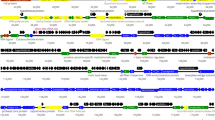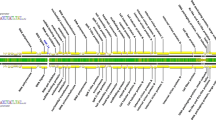Abstract.
The φ29-like phage genus of Podoviridae family contains phages B103, BS32, GA-1, M2, Nf, φ15, φ29, and PZA that all infect Bacillus subtilis. They have very similar morphology and their genomes consist of linear double-stranded DNA of approximately 20 kb. The nucleotide sequences of individual genomes or their parts determined thus far show that these phages evolved from a common ancestor. A terminal protein (TP) that is covalently bound to the DNA 5′-end primes DNA replication of these phages. The same mechanism of DNA replication is used by the Cp-1 related phages (also members of the Podoviridae family) and by the phage PRD1 (member of the Tectoviridae family). Based on the complete or partial genomic sequence data of these phages it was possible to analyze the evolutionary relationship within the φ29-like phage genus as well as to other protein-primed replicating phages. Noncoding regions containing origins of replication were used in the analysis, as well as amino acid sequences of DNA polymerases, and with the φ29-like phages also amino acid sequences of the terminal proteins and of the gene 17 protein product, an accessory component of bacteriophage DNA replicating machinery. Included in the analysis are also results of a comparison of these phage DNAs with the prophages present in the Bacillus subtilis genome. Based on this complex analysis we define and describe in more detail the evolutionary branches of φ29-like phages, one branch consisting of phages BS32, φ15, φ29, and PZA, the second branch composed of phages B103, M2, and Nf, and the third branch having phage GA-1 as its sole member. In addition, amino acid sequences of holins, proteins involved in phage lysis were used to extend the evolutionary study to other phages infecting Gram-positive bacteria. The analysis based on the amino acid sequences of holins showed several weak points in present bacteriophage classification.
Similar content being viewed by others
Author information
Authors and Affiliations
Additional information
Received: 14 April 1998 / Accepted: 31 July 1998
Rights and permissions
About this article
Cite this article
Pečenková, T., Pačes, V. Molecular Phylogeny of φ29-Like Phages and Their Evolutionary Relatedness to Other Protein-Primed Replicating Phages and Other Phages Hosted by Gram-Positive Bacteria. J Mol Evol 48, 197–208 (1999). https://doi.org/10.1007/PL00006458
Published:
Issue Date:
DOI: https://doi.org/10.1007/PL00006458




